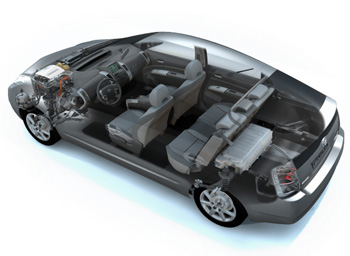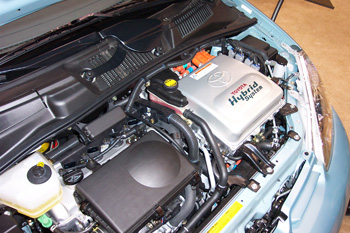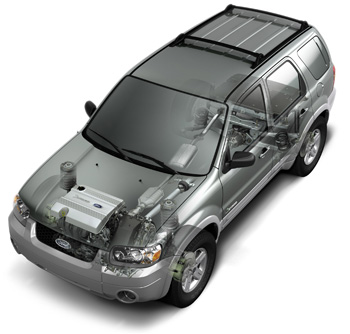 In light of unstable fuel costs, consumers are once again returning to basic transportation by trading in their old gas-guzzling SUVs for more economical vehicles, especially those powered by hybrid electric vehicle (HEV) technology. This was especially evident in last year’s Cash For Clunkers program, which had to be extended due to the surprisingly swift consumer response to the program.
In light of unstable fuel costs, consumers are once again returning to basic transportation by trading in their old gas-guzzling SUVs for more economical vehicles, especially those powered by hybrid electric vehicle (HEV) technology. This was especially evident in last year’s Cash For Clunkers program, which had to be extended due to the surprisingly swift consumer response to the program.
Hybrid vehicles did make the top 10 list of vehicles purchased during the Car Allowance Rebate System (CARS). On the one hand, the current popularity of hybrid technology seems to offer an unbounded service opportunity for independent automotive service providers. On the other hand, a currently limited, 1-million HEV population might be operating under an eight-year, 80,000-mile manufacturer’s “49-state” warranty or an extended warranty in California.
Right now, the service opportunities lie mainly in the future, as hybrids move out of warranty and into the independent service bays. In either case, it’s entirely realistic to expect hybrids to become a growing part of the automotive service market. So let’s take a brief look at what hybrid technology is all about and what effect it might have on the independent service market.
Decade of Dual Power
The first commercially produced hybrid car to hit the road was the Honda Insight back in 2000, followed by the Toyota Prius for model year 2001. But both of these cars were very limited production vehicles. The Honda Insight was discontinued in 2007, replaced by a hybrid version of the Civic. The Prius lives on, and continues as the most numerous and popular hybrid on the road today.
Hybrid Talk
Most major auto manufacturers have some type of hybrid design in the various stages of planning, manufacturing or marketing. Although hybrid designs have been on the market for about 10 years, only recently have the “global warming” movement and rising oil prices focused the nation’s attention on the hybrid’s high fuel economy and low greenhouse gas exhaust emissions. In fact, driving a hybrid has become as much of an environmental status symbol as it has a matter of thrift.
When discussing hybrids, it’s important to remember that hybrid technology is a work in progress and that there’s no such thing as a “generic” hybrid design. Hybrids use three fundamentally different powertrain arrangements — series, parallel and series-parallel — to transmit mechanical and electrical torque to the front wheels and to recharge the vehicle’s main batteries. 
Battery technology is also progressing from nickel metal hydride (Ni-MH) to lithium ion-based designs, which means that an HEV’s storage capacity will markedly increase, as will the service life and the projected cost of the batteries.
Next, remember that the terms, “engine” and “motor” are not interchangeable in hybrid or any other alternative motive power technology.
An internal combustion engine (ICE) develops rotating torque by converting one form of energy (gasoline) into another form of energy (heat), which is converted into mechanical energy that rotates the engine’s crankshaft. The electric motor (EM), on the other hand, develops rotating torque by directly converting electricity into a magnetic force that rotates the motor’s armature shaft. Although many hybrids use a conventional 12-volt starter motor and ring gear as a backup, the hybrid’s electric drive motor normally serves as a silent starter motor for the gasoline engine.
Last, it’s important to understand that power management in a hybrid or other alternative motive power technologies is accomplished by using a complex computer system to monitor and coordinate all vehicle functions. Modern hybrids use the latest computer networking, electrical multiplexing and drive-by-wire technologies to operate practically all systems and subsystems and to achieve optimum fuel economy and exhaust emissions.
Modern hybrids also use regenerative braking to recharge the batteries during deceleration. Regenerative braking, in most cases, conserves gasoline by transforming the kinetic energy of the vehicle into electrical energy that can be used to not only slow the vehicle, but also to recharge the vehicle’s batteries. In most cases, the hydraulic service brakes operate only under severe braking conditions or to merely slow or stop the vehicle at low vehicle speeds.
Last, a hybrid’s gasoline engine runs only when the batteries need charging or when additional power is required for climbing hills or passing other vehicles. This feature not only saves gasoline, but saves wear and tear on the engine itself.
Hybrid Population
When you add up all the hybrids that are on the road today, they total about 1 million vehicles — which is less than 1% of the vehicle population. Hybrids are still a very small drop in a very large bucket. Within five years, however, these numbers will change dramatically. Hybrids are expected to account for 20% to 25% of all new car and light truck sales by 2013. That means a growing aftermarket for replacement parts.
Providing Hybrid Service
Hybrid service can be broken into three categories: routine maintenance, engine service and transaxle/battery service. Routine maintenance includes the lubrication, filter and inspection services that all conventional vehicles require. The only difference is that hybrid vehicles require less routine maintenance than normal because: 1) the gasoline engine runs only when required; and 2) the conventional hydraulic service brakes operate only during emergency situations or at very low vehicle speeds.
The spark plug replacement interval for the iridium-tipped spark plugs on a 2006 Toyota Prius, for example, is 120,000 miles versus a 100,000-mile interval for conventional platforms.
Taxi drivers using the Toyota Prius vehicles in metro taxi service are reporting a brake friction life in excess of 100,000 miles. Battery life is also estimated to average about 10 years, so it’s not quite accurate to say that there’s a pent-up demand awaiting the shop that gears up for routine hybrid maintenance.
The gasoline engine itself falls under EPA requirements for the tooling and information needed to diagnose and repair emissions-related failures. Since the engine is completely computer-controlled, technicians must familiarize themselves with correct service procedures including “locking” the vehicle to prevent the engine from attempting to start automatically during a routine service such as an oil change. In addition, technicians must understand that hybrid vehicles require special service and repair procedures.
The Prius’s 12-volt absorbed glass mat (AGM) auxiliary battery for operating accessories, for example, must be recharged using a special Toyota battery charger or a low-amperage equivalent.
Last, attention must be paid to vehicle-specific details when performing routine maintenance on hybrid vehicles. Honda Insights, for example, incorporate aluminum bodies held together by special corrosion-resistant bolts. Some hybrids use a letter mark on the end of the spark plug electrode to index the spark plug gaps to the cylinder’s combustion chambers. Similarly, all hybrid vehicles use special low-rolling resistance tires. Using generic substitutes will reduce fuel economy, which, in most cases, will be immediately noticed by a mileage-conscious owner.
 Any service or repair involving the high-voltage (HV) system, which includes the transaxle, electric generator, drive motors, constant variable speed transaxles and the high-voltage batteries, requires special technical training and service safety precautions. The generator/motor assemblies and constant variable speed transaxles are currently supplied only as new, complete assemblies from the hybrid manufacturers. Very few major components in the hybrid design lend themselves to in-house servicing or rebuilding.
Any service or repair involving the high-voltage (HV) system, which includes the transaxle, electric generator, drive motors, constant variable speed transaxles and the high-voltage batteries, requires special technical training and service safety precautions. The generator/motor assemblies and constant variable speed transaxles are currently supplied only as new, complete assemblies from the hybrid manufacturers. Very few major components in the hybrid design lend themselves to in-house servicing or rebuilding.
When servicing hybrids, keep in mind that contact with any voltage potential of 60 volts or more can be fatal. Generator voltages can range as high as 500 volts and battery voltages can range as high as 300 volts. To warn technicians of the danger, all high-voltage wiring is colored orange. Special high-voltage electrical test and safety equipment like high-voltage insulating gloves are required for servicing high-voltage battery systems.
With that said, any independent shop must evaluate the potential costs and profits of servicing hybrid vehicles. Routine maintenance and engine service, of course, requires no appreciable amount of special equipment. Generator/motor, transaxle and battery service, on the other hand, requires vehicle-specific training and some special tooling like high-voltage insulated gloves and high-voltage electrical test equipment.
In-depth service might also require an OE database like Toyota’s new TechStream information system. This system costs about $8,000 for a complete OE diagnostic hardware and data access package, but is necessary to diagnose the on-board electronics and access the latest module calibrations.
But technology keeps moving on. One European manufacturer is looking at adapting some hybrid features into its conventional vehicle platforms by automatically shutting off the engine when the vehicle is at rest. At future prices of gasoline, this and other hybrid-style fuel-saving features may well point the way to major changes in the way the automotive aftermarket provides service and parts to the motoring public.












